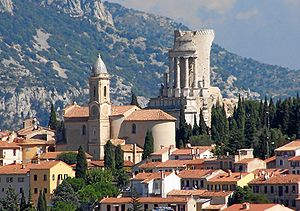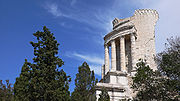
Trophy of Augustus
Encyclopedia


Ancient Rome
Ancient Rome was a thriving civilization that grew on the Italian Peninsula as early as the 8th century BC. Located along the Mediterranean Sea and centered on the city of Rome, it expanded to one of the largest empires in the ancient world....
for the emperor
Roman Emperor
The Roman emperor was the ruler of the Roman State during the imperial period . The Romans had no single term for the office although at any given time, a given title was associated with the emperor...
Augustus
Augustus
Augustus ;23 September 63 BC – 19 August AD 14) is considered the first emperor of the Roman Empire, which he ruled alone from 27 BC until his death in 14 AD.The dates of his rule are contemporary dates; Augustus lived under two calendars, the Roman Republican until 45 BC, and the Julian...
to celebrate his definitive victory over the ancient tribes which populated the Alps
Alps
The Alps is one of the great mountain range systems of Europe, stretching from Austria and Slovenia in the east through Italy, Switzerland, Liechtenstein and Germany to France in the west....
. The mounument's remains are in the commune
Communes of France
The commune is the lowest level of administrative division in the French Republic. French communes are roughly equivalent to incorporated municipalities or villages in the United States or Gemeinden in Germany...
of La Turbie
La Turbie
La Turbie is a commune in the Alpes-Maritimes department in southeastern France.-History:...
(France
France
The French Republic , The French Republic , The French Republic , (commonly known as France , is a unitary semi-presidential republic in Western Europe with several overseas territories and islands located on other continents and in the Indian, Pacific, and Atlantic oceans. Metropolitan France...
), a few kilometers from the Principality of Monaco (Latin: tropaeum from Greek: tropaion
Tropaion
A tropaion , whence English "trophy" is an ancient Greek and later Roman monument set up to commemorate a victory over one's foes. Typically this takes the shape of a tree, sometimes with a pair of arm-like branches upon which is hung the armour of a defeated and dead foe...
whence English: "trophy
Trophy
A trophy is a reward for a specific achievement, and serves as recognition or evidence of merit. Trophies are most often awarded for sporting events, from youth sports to professional level athletics...
").
Construction
The Trophy was built c. 6 BC in honor of the emperorRoman Emperor
The Roman emperor was the ruler of the Roman State during the imperial period . The Romans had no single term for the office although at any given time, a given title was associated with the emperor...
Augustus
Augustus
Augustus ;23 September 63 BC – 19 August AD 14) is considered the first emperor of the Roman Empire, which he ruled alone from 27 BC until his death in 14 AD.The dates of his rule are contemporary dates; Augustus lived under two calendars, the Roman Republican until 45 BC, and the Julian...
to celebrate his definitive victory over the 45 ancient tribes who populated the Alps
Alps
The Alps is one of the great mountain range systems of Europe, stretching from Austria and Slovenia in the east through Italy, Switzerland, Liechtenstein and Germany to France in the west....
. The alpine populations were defeated during the military campaign to conquest the Alps conducted by the Romans between 16 and 7 BC.
The stone used to build the monument was originally extracted from the Roman quarry located about 500 meters away. Visitors to that site can still see the traces of sections of carved columns in the stone.
The monument as partially restored by archaeologists at the beginning of the 20th century, is 35 meters high. When built, according to the architect, the base measured 35 meters in length, the first platform 12 meters in height, and the rotunda of 24 columns with its statue of an enthroned Augustus is 49 meters high.
Inscription
One of the stones of the tower, which Pliny the ElderPliny the Elder
Gaius Plinius Secundus , better known as Pliny the Elder, was a Roman author, naturalist, and natural philosopher, as well as naval and army commander of the early Roman Empire, and personal friend of the emperor Vespasian...
transcribed, contained the names of the tribes. It reads:
· The TRUMPILINI
· The CAMUNNI
Camunni
The Camuni or Camunni were an ancient population located in Val Camonica during the Iron Age ; the Latin name Camunni was attributed to them by the authors of the 1st century. They are also called ancient Camuni, to distinguish them from the current inhabitants of the valley...
· The VENOSTES
· The VENNONETES
· The ISARCI
· The BREUNI
· The GENAUNES
· The FOCUNATES
· The four nations of the VINDELICI
Vindelicia
In the pre-Roman geography of Europe, Vindelicia identifies the country inhabited by the Vindelici, a region bounded on the north by the Danube and the Hadrian's Limes Germanicus, on the east by the Oenus , on the south by Raetia and on the west by the territory of the Helvetii...
:
· COSUANETES
· RUCINATES
· LICATES
· CATENATES
· The AMBISONTES
· The RUGUSCI
· The SUANETES
· The CALUCONES
Calucones
The Calucones were a Germanic tribe mentioned by a few of the classical sources, but not all. Pliny the Elder quotes a monument to the reign of Augustus, the tropeaum Alpium, located in the Rhaetia of his day, stating that Augustus subdued the Alpine peoples from the upper sea to the lower sea,...
· The BRIXENETES
· The LEPONTII
Lepontii
The Lepontii were an ancient people occupying portions of Rhaetia in the Alps during the time of the Roman conquest of that territory. The Lepontii have been variously described as a Celtic, Ligurian, Raetian, and Germanic tribe...
· The UBERI
· The NANTUATES
Nantuates
The Nantuates or Nantuatae were an ancient people of modern day Switzerland, whose territory extended into adjacent areas now in modern-day France....
· The SEDUNI
Seduni
The Seduni or Sedunii were an ancient people in the valley of the Upper Rhone at Roman contact, whom Julius Caesar mentions: Nantuates Sedunos Veragrosque. These tribes were conquered by Rome are also mentioned in the Trophy of the Alps in the same order. They were east of the Veragri, in the...
· The VERAGRI
Veragri
The Veragri were an ancient tribe located in present day Switzerland. The Veragri are placed by Julius Caesar in the canton of Valais between the Nantuates and the Seduni. Their chief town was Octodurus , whence the Veragri are called Octodurenses by Pliny. Dio Cassius The Veragri (Greek: ) were...
· The SALASSI
Salassi
The Salassi were an Alpine tribe whose lands lay on the Italian side of the Little St Bernard Pass across the Graian Alps to Lyons, and the Great St Bernard Pass over the Pennine Alps...
· The ACITAUONES
· The MEDULLI
Medulli
A Gaulish people, the Medulli belonged to the group of mountain tribes controlling access to high Alps passes, along with the Centrones in Tarentaise Valley and the Salassi in Aosta Valley, especially for the trade of metals...
· The UCENNI
· The CATURIGES
Caturiges
The Caturiges were a Celtic Alpine tribe in the ancient Roman province of Alpes Maritimae, at first located on the Druentia river , towards its source, west of Vapincum , but later extending into Viennensis and Narbonensis....
· The BRIGIANI
· The SOGIONTI
· The BRODIONTI
· The NEMALONI
· The EDENATES
· The VESUBIANI
· The VEAMINI
· The GALLITAE
· The TRIULLATI
· The ECDINI
· The VERGUNNI
· The EGUITURI
· The NEMATURI
· The ORATELLI
· The NERUSI
· The VELAUNI
· The SUETRI.
Later life
The monument originally served no military purpose and contained no fortress. Rather, it marked the boundary between Italy and Gallia NarbonensisGallia Narbonensis
Gallia Narbonensis was a Roman province located in what is now Languedoc and Provence, in southern France. It was also known as Gallia Transalpina , which was originally a designation for that part of Gaul lying across the Alps from Italia and it contained a western region known as Septimania...
, later pushed back to the Var
Var River
The Var is a river located in the southeast of France. The name Var originates from the Ligurian word for waterway.The Var flows through the Alpes-Maritimes département for most of its length, with a short stretch in the Alpes-de-Haute-Provence département...
. Between the 12th and 15th centuries, however, the Trophy did become a fortress, with locals building houses around its walls. In 1705, when war broke out between Savoy
Savoy
Savoy is a region of France. It comprises roughly the territory of the Western Alps situated between Lake Geneva in the north and Monaco and the Mediterranean coast in the south....
and France
France
The French Republic , The French Republic , The French Republic , (commonly known as France , is a unitary semi-presidential republic in Western Europe with several overseas territories and islands located on other continents and in the Indian, Pacific, and Atlantic oceans. Metropolitan France...
during the War of the Spanish Succession
War of the Spanish Succession
The War of the Spanish Succession was fought among several European powers, including a divided Spain, over the possible unification of the Kingdoms of Spain and France under one Bourbon monarch. As France and Spain were among the most powerful states of Europe, such a unification would have...
, Louis XIV ordered the destruction of all fortresses in the region, including this one. The partially destroyed Trophy then became a quarry and its stones were used, among other things, to build the nearby church of Saint-Michel.
Nearby Roman remains
The area surrounding the Trophy is rich with remnants of the Roman empire such as the famous Roman roads. The Trophy is situated on the Via Julia AugustaVia Julia Augusta
The Via Julia Augusta is the name given to the Roman road formed by the merging of the Via Aemilia Scauri with the Via Postumia. The road runs from Placentia to Arelates through Derthona , Vada Sabatia , Albingaunum and Album Intimilium .It was begun in 13 BC by Augustus, and originally stopped...
, named after the emperor Augustus, which is a continuation of the Via Aurelia
Via Aurelia
The Via Aurelia was a Roman road in Italy constructed around the year 241 BC. The project was undertaken by C. Aurelius Cotta, who at that time was censor...
which linked Vintimille
Ventimiglia
Ventimiglia is a city and comune in Liguria, northern Italy, in the province of Imperia. It is located southwest of Genoa by rail, and 7 km from the French-Italian border, on the Gulf of Genoa, having a small harbour at the mouth of the Roia River, which divides the town into two parts...
to Cimiez
Cimiez
Cimiez is a neighborhood in Nice, southern France. The area contains the Musée Matisse and the ruins of Cemenelum, capital of the Ancient Roman province Alpes Maritimae on the Ligurian coast...
(Nice
Nice
Nice is the fifth most populous city in France, after Paris, Marseille, Lyon and Toulouse, with a population of 348,721 within its administrative limits on a land area of . The urban area of Nice extends beyond the administrative city limits with a population of more than 955,000 on an area of...
). Various fountains within the territory of the communes of Beausoleil
Beausoleil, Alpes-Maritimes
Beausoleil is a commune in the Alpes-Maritimes department in southeastern France. It adjoins the Principality of Monaco.Beausoleil was formerly known as Monte-Carlo-Supérieur .-Economy:...
and Roquebrune-Cap-Martin
Roquebrune-Cap-Martin
Roquebrune-Cap-Martin is a commune in the Alpes-Maritimes department in southeastern France between Monaco and Menton. The name was changed from Roquebrune to differentiate the town from Roquebrune-sur-Argens in the neighboring Var Department.-History:In pre-Roman times the area was settled by the...
are also said to be Roman.

